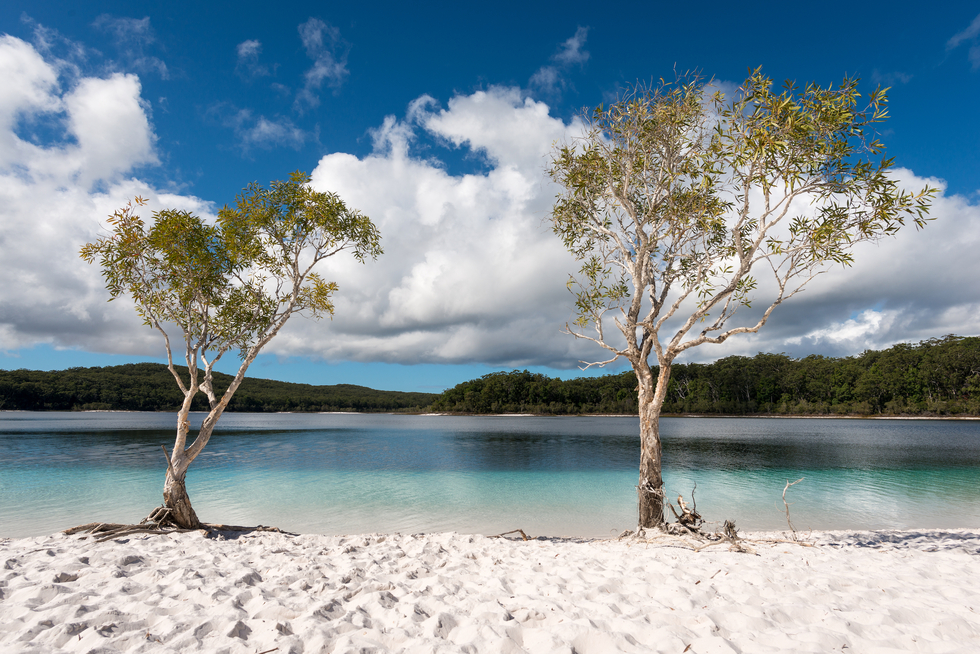You could call it a much-delayed rebuke of propaganda.
Australia's Fraser Island, a popular nature destination just off the coast of Queensland, is reverting to what it was called before a mendacious Englishwoman gave the spot a bad name.
When Europeans first showed up in this part of the world and got to know the 76-mile-long island, which juts into the sea 186 miles north of the city of Brisbane, they dubbed the place Great Sandy Island—a stroke of impoverished imagination fairly typical of explorers in the era. You see, it's a big island with lots of sand.
In fact, this is the world's largest sand island. Today, it attracts some 400,000 visitors a year who come to snorkel, kayak, go whale watching, ride four-wheel-drive vehicles in the wilderness, and spot members of the wild dingo population. Part of the island has been named to the UNESCO World Heritage List.
In May 1836, an Englishwoman named Eliza Fraser, whose husband was the master of the brig Stirling Castle, found herself shipwrecked on Great Sandy Island.
When she was finally rescued, Fraser became a pop culture celebrity back home, thanks to fabulous lies about her misadventures that were published in the newspapers as a new distortion of the then-popular Robinson Crusoe tale. Some ridiculous claims gained traction, including that Fraser was brutally held captive by the island's Badtjala (Butchulla) people, who were described as savage rapists and cannibals when, in truth, they had tried to help the ship's survivors.
Such sensationalistic flimflam did great damage to the reputation of Aboriginal people in Australia at a critical moment of expanding colonial conquest. The island's Indigenous residents were, in fact, neither man-eaters nor woman-kidnappers. Fraser's fellow shipwreck survivors even disputed her salacious tale, but to no avail. The yarns sold papers and a bestselling book, and Westerners ate up the scandalous stereotypes about native people in the burgeoning colony of Australia.
Eliza Fraser, described by one sailor as "a most profane, artful wicked woman," used her notoriety to petition for donations from the public, a scheme that in turn became the subject of an inquiry. Nevertheless, Fraser's dubious cultural impact is still the topic of academic analysis.
Anyway, the island became known as Fraser Island. You can see why the people who live there wouldn't be crazy about that.
Finally, after nearly 200 years of bearing a name with those ignoble origins, Fraser Island is officially K’gari, its true historic name, once again.
Aunty Joyce Bonner, the language and cultural coordinator for the modern-day Butchulla people, said of the renaming, “K’gari means to me, home. Home amongst my people, the descendants, the ancestors, the Midiru (traditional owners). It’s our place. It’s what we call home.”
According to Bonner, "K’gari is spelt with a K or a G. The K is a silent K as in know, knew, knife."
Or, if you're Eliza Fraser, knasty know-nothing.
It's not the first time a boorish naming wrong has been righted at a major Australian vacation destination.
In 1873, when an English-born man, William Gosse, became one of the first Europeans to lay eyes on the mighty red desert monolith known as Uluru, he promptly renamed it Ayers Rock in order to butter up the English-born bureaucrat who had sponsored Gosse's trip. Ayers had never even been there.
To make matters worse, Gosse climbed the rock in a display of conquest—and a display of disrespect, given that Uluru is considered sacred and off-limits by local Indigenous residents, the Yankunytjatjara and Pitjantjatjara people.
Despite being one of Australia's most important religious, cultural, and touristic icons, Uluru was still officially called Ayers Rock until 1993, when the traditional name was restored.
Plenty of people still refer to Uluru as "Ayers Rock" out of habit, and plenty will take their time to adopt "K'gari" instead of Fraser Island. But over time that will change and these remnants of colonial bossiness will fade into the history books.
For the record, Eliza Fraser faded into obscurity herself and died in 1858. William Gosse, who named Uluru for his donor and then defiled the site by climbing it, died just eight years later at age 38. Climbing Uluru is now forbidden by law.







